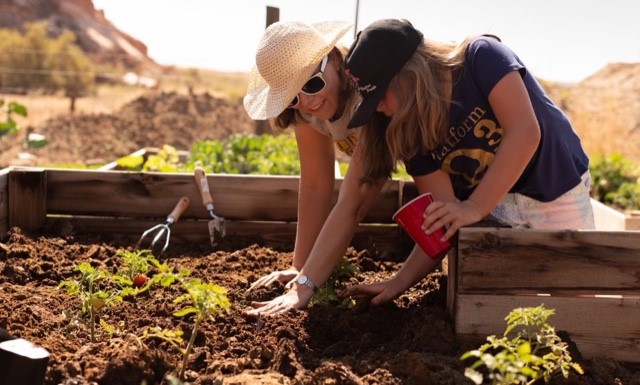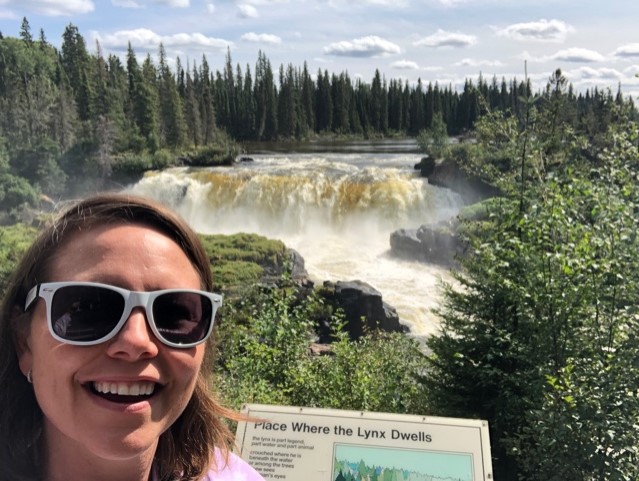Reawaken to the Honorable Harvest
by Ashley Hubbard
I am honored to be writing for the May Creation Care newsletter and hope you will join me in ushering in a season of rejuvenation and gratitude focused on remembering and reciprocity as we give thanks to Creator for the bounty of Earth. Can you sense it? The days are getting longer and warmer. With more sunlight, our garden seedlings are transforming into their vegetative state. Soon they will bud and bear fruit. Students and teachers across the country are moving to the end of a rigorous school year in anticipation for some relaxation and recreation. Summer is upon us; it is time to slow down and recalibrate. It is a time to take stock of what truly matters and cultivate habits of generosity. Whether you enjoy going to the beach, the mountains, or your local state park – I pray you will take time out of doors and experience the healing nature of Creation. If you are anything like me, summertime provides an opportunity to catch up on reading. In this edition of the newsletter, I hope to bring forth some interesting titles centered on the theme of Creation Care. These books are not designed to help you escape – like the typical beachside or poolside read. My hope is that these titles will inspire you to consider Creation Care as a worthwhile spiritual practice. This summer, let us participate in reawakening to Christ’s call towards deeper relationship through Creation. Let us practice remembrance by reconnecting to the Land who loves us as our Mother. Finally, let us perform acts of reciprocity – which is resurgence – for we are all Indigenous to a homeplace.
The first book is John Philip Newell’s Sacred Earth, Sacred Soul: Celtic Wisdom for Reawakening to What Our Souls Know and Healing the World (HarperOne, 2021). This book is endorsed by many well-known theologians including Archbishop Michael Curry and Rev. Barbara Brown Taylor, but you should read it because it embraces the wisdom of Celtic Christianity by calling us to the ancient practice of remembrance. I read this book on retreat near Tuckahoe State Park in Maryland and Newell’s concept of sacred sounding – everything in Creation is a unique and unrepeatable expression of the One – reverberated as spent time in the forest witnessing the chorus of Creation. I listened and watched for life, considered each species, gave thanks to God, and aggrieved those species no longer present.
In this book, Newell takes readers on a journey towards the sacred beginning with Pelagius – one of the most misrepresented Christian teachers of all time who is still misrepresented today.[1] Highlighting Pelagius’ five-fold focus of sacredness – the human soul, nature, spiritual practice, wisdom, compassion – readers are invited to remember that every life form is in essence divine and explore creatio ex nihilo with freshness and boldness. Newell highlights St. Brigid of Kildare, John Scotus Eriugena, John Muir, and Pierre Teilhard de Chardin, Kenneth White and others to provide the antidote for what the Celtic tradition deems soul-forgetfulness. Newell charges readers to reawaken the deep knowledge at the core of humanity’s being – that which is waiting in the recesses and longing to be tapped. Creation is waiting – groaning in travail (Romans 8: 22) – for humanity to reawaken to the sacredness of all things. Newell leaves no stone unturned to move us towards reimagining our relationship with Earth – hermeneutical approaches to Scripture, church doctrine, Industrialization, empire, reconciliation, sacramental theology, and sacred generosity. Celtic wisdom provides a vision for Creation care that calls for remembrance grounded in action. May it help us rediscover our place in Creation, and welcome true relationship with Earth.
The second book I would like to offer is a title I read while taking an Indigenous sustainability course at Vancouver School of Theology with Cherokee scholar Dr. Jeff Corntassel – Nancy J. Turner’s book Plants, People, and Places: The Roles of Ethnobotany and Ethnoecology in Indigenous Peoples’ Land Rights in Canada and Beyond (McGill-Queen’s University Press, 2020). Indigenous sustainability, unlike other environmental ethics and ecojustice courses I have taken, focused on relationships with the Land and contemplating ways to be a good ancestor. One of the guiding questions posed by Dr. Corntassel was to consider how my ancestors might recognize me through actions. This book offers themes of Indigenous environmental stewardship by recognizing sacred space, identifying cultural keystone species, practicing an honorable harvest through of reciprocity, and protecting and promoting Indigenous wisdom, storytelling, and land-use practices. As we tend our gardens, and wait for the bounty of Mother Earth, let us focus on being good ancestors by practicing reciprocity.
I am reminded of a story about Cultivate VTS and my first garden planted in Alexandria. Cultivate VTS is a student-led sustainability group on the campus of Virginia Theological Seminary that is committed to providing space for the seminary community to experience the transformational power of sustainable agriculture. In years past, the gardens at VTS have been situated on distant sites around campus that lacked a water source. Since 2019, the Cultivate VTS garden has been relocated to the heart of campus, and through collaborative Eagle Scout projects twelve garden beds and a tool bin have been constructed. Furthermore, composters and a rain barrel added to the garden now support the cycle of sustainable growth on campus. After reading Robin Wall Kimmerer’s Braiding Sweetgrass, I was determined that my first planting in this new garden space would be a Three Sisters companion planting garden of corn, beans, and squash.[2] This ancient farming practice, which has been implemented by many Indigenous tribes, is a quintessential example of harmony and agricultural genius. The corn kernels draw in water and provide a sturdy trellis for the beans to climb, the squash provides shade and locks in moisture, and the beans provide sustenance by fixing nitrogen in the soil. When these species are planted together, their “organic symmetry” has a far greater yield than if they were planted alone in a monocropping fashion.[3] What is more, the yield is secondary to the life-lesson the Three Sisters planting teaches – to respect one another, support one another, bring your gift to the world, and receive the gifts of others and there will be enough for all.[4]
In the garden that year, I planted a Navajo blue corn variety given to me by a close Diné friend. I understood the importance of growing ancient seed varieties as a form of “resurgence,” however, the lessons this traditional species taught me were quite unexpected.[5] Specifically, corn is more than produce, it is a cultural keystone species[6] that demands a reciprocal relationship in order to be successful. This concept was a new one for me. As a young girl, I helped my grandmother tend our ¼ acre garden, however, I do not remember having to do much management outside of watering or weed and pest control. Honestly, I thought the Navajo blue corn would just grow without my ever having to supervise it. Wow, was I wrong! The corn produced very small ears that were misshaped and had few kernels sporadically dotting it. The corn looked so bad that other gardeners became interested in discovering why my corn failed so miserably. I learned that corn is not pollenated by bees, but by the wind. I would venture to say that the wind blew enough to pollenate my crop that summer. There is something more to this crop failure than meets the eye. I suspect the corn did not thrive because it was waiting for the traditional Navajo protocols for planting, collecting corn pollen, and harvesting. The corn was not waiting on the wind, it was failing due to a lack of human interaction- there was no relationship of reciprocity. I did not know the corn, and all I offered was crop management. The Navajo blue corn taught me that protocol is necessary and provides a blueprint for forming reciprocal relationships. This is why the Green Corn and Corn Pollen ceremonies are so important – they establish bonds which cultivate relationships of responsibility where each party involved thrives.
Now that I understand relationships of reciprocity and responsibility a little bit better, my desire to affirm food sovereignty has emerged.[7] Yes, food sovereignty is an act of resurgence because it reclaims Indigenous identity and highlights Indigenous land-based practices. However, it is so much more! Indigenous food sovereignty provides the most nutritious foods and is good for the whole Earth.[8] It is a step towards reconciliation with non-Indigenes and promotes wellness and self-healing within the Indigenous community.[9] Finally, Indigenous food sovereignty is a way in which I can practice being a good ancestor by having my ancestors and future generations recognize me.[10]
When the wind blows, we imagine she is erasing every injustice,
sweeping misdoings from the east to the west,
making room for something new, a more whole world.
Instead, what we don’t realize is that she is rustling the tree branches
to sing us a song.
Instead, she is sowing seeds across the landscapes,
seeds that tomorrow will become the beauty that restores us.
sweeping misdoings from the east to the west,
making room for something new, a more whole world.
Instead, what we don’t realize is that she is rustling the tree branches
to sing us a song.
Instead, she is sowing seeds across the landscapes,
seeds that tomorrow will become the beauty that restores us.
Instead, she is whispering for us to hold on, to keep
going,
to water those seeds, because one day, they will show us the way home.[11]
Kaitlin B. Curtice, Native: Identity, Belonging, and Rediscovering God
I pray this summer brings us all rejuvenation, creativity, and wholeness as we seek new spiritual practices that honor and care for Creation. May your ancestors (past and future) recognize you and I pray that we all have an honorable harvest.


My name is Ashley Hubbard and I am a seminarian at Virginia Theological Seminary (VTS). VTS is located in Alexandria, Virginia – the traditional homeland of the Conoy Chiefdom including the Nacotchtank, Tauxenents, and Piscataway Nations. I am grateful for each of these tribes, and their stewardship of the land. Their hospitality allows me to live, study, work, and worship Creator here where I drink water from the Potomac River. Upon graduation next May, I will join my husband (of 18 years) in full-time Indigenous ministry where we serve alongside the Diné peoples in the Utah region of the Episcopal Church on Navajoland. Joe and I have three beautiful children (Hill-13 years old, Hattie-10 years old, and Hannah-8 years old), and a German short-haired pointer named Bubba.
[1] John Philip Newell, Sacred Earth, Sacred Soul: Celtic Wisdom for Reawakening to What Our Souls Know and Healing the World (New York: HarperOne , 2021), 29.
[2] Robin Wall Kimmerer, Braiding Sweetgrass: Indigenous Wisdom, Scientific Knowledge, and the Teaching of Plants (Minneapolis: Milkweed Editions, 2013), 129.
[3] Kimmerer, Braiding Sweetgrass, 32.
[4] Kimmerer, Braiding Sweetgrass, 32.
[5] Jeannette Armstrong, “Living from the Land: Food Security and Food Sovereignty Today and into the Future,” in Plants, People, and Places: The Roles of Ethnobotany and Ethnoecology in Indigenous Peoples’ Land Rights in Canada and Beyond, ed. Nancy J. Turner (Chicago: McGill-Queen’s University Press, 2020), 46.
[6] Ann Garibaldi and Nancy Turner, “Cultural Keystone Species: Implications for Ecological Conservation and Restoration,” Ecology and Society 9, no. 3 (2004), accessed May 1, 2022, https://www.ecologyandsociety.org/vol9/iss3/art1/. See also Jeff Corntassel, “Re-Envisioning Resurgence: Indigenous Pathways to Decolonization and Sustainable Self-Determination,” Decolonization: Indigeneity, Education and Society 1, no. 1 (2012): 86-101, accessed May 4, 2022, https://jps.library.utoronto.ca/index.php/des/article/view/18627/15550.
[7] Jeannette Armstrong, “Living from the Land: Food Security and Food Sovereignty Today and into the Future,” in Plants, People, and Places: The Roles of Ethnobotany and Ethnoecology in Indigenous Peoples’ Land Rights in Canada and Beyond, ed. Nancy J. Turner (Chicago: McGill-Queen’s University Press, 2020), 48.
[8] Armstrong, “Living from the Land,” 48.
[9] Armstrong, “Living from the Land,” 47.
[10] Jeff Corntassel, “Re-Envisioning Resurgence: Indigenous Pathways to Decolonization and Sustainable Self-Determination,” Decolonization: Indigeneity, Education and Society 1, no. 1 (2012): 86-101, accessed May 4, 2022, https://jps.library.utoronto.ca/index.php/des/article/view/18627/15550.
[11] Kaitlin B. Curtice, Native: Identity, Belonging, and Rediscovering God (Grand Rapids: Brazos Press, 2020), 66.

